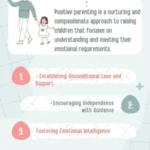In recent years, the notion of positive parenting has acquired considerable prominence. It stresses developing strong, supportive ties with children and nourishing their emotional and psychological well-being. But what exactly does good parenting look like in action? In this thorough guide, we’ll dig into real-life instances of good parenting and examine its myriad advantages for both parents and children.
Understanding Positive Parenting
Before we get into particular instances, let’s obtain a clear idea of what positive parenting comprises. Positive parenting is not a one-size-fits-all method, but it is founded on three core ideas that help parents in nurturing their children:
1. Emotional Connection: Building a deep emotional relationship with your kid builds the cornerstone of excellent parenting. This link creates trust and successful communication.
2. Clear Expectations: Positive parenting entails establishing clear, age-appropriate expectations for your children. These expectations help youngsters comprehend limits and standards.
3. Healthy Reinforcement: Recognizing and applauding excellent conduct is a cornerstone of healthy parenting. It stimulates youngsters to repeat good acts, enhancing their self-esteem.
4. Empathy and Understanding: Understanding your child’s feelings and viewpoint is vital. Positive parenting helps parents to sympathize with their child’s emotions and experiences.
5. Effective Communication: Open and honest communication is vital for creating successful parent-child interactions. Positive parenting promotes active listening and encourages children to communicate their views and feelings.
6. Consistency: Consistency in discipline and expectations gives children with stability and predictability, generating a feeling of security.
Real-Life Examples of Positive Parenting
Now, let’s study actual instances of how positive parenting ideas may be utilized in real life:
Example 1: The Power of Encouragement
Imagine your youngster has just begun learning to ride a bike. Instead of concentrating on their early wobbles and stumbles, you provide enthusiastic support. You commend their efforts and emphasize their progress, increasing their confidence. This positive reinforcement drives children to keep trying and finally master the skill.
Example 2: Active Listening
Your adolescent comes home from school looking distressed. Instead of instantly proposing answers, you sit down with them and really listen to their issues. You sympathize with their sentiments and validate their experiences. This open conversation enhances your relationship and helps your youngster feel understood and supported.
Example 3: Setting Boundaries with Empathy
Suppose your little kid refuses to go to bed at night. Instead of turning to punitive methods, you gently explain the value of sleep and how it helps them. You establish clear standards while appreciating their want to remain up a bit longer. This method helps your youngster comprehend the rules while feeling heard and appreciated.
The Benefits of Positive Parenting
Positive parenting has various advantages for both children and parents:
For Children:
- Improved Emotional management: Children raised in a happy parental setting tend to have higher emotional management abilities. They can comprehend and regulate their emotions properly.
- Boosted Self-Esteem: Regular positive reinforcement and emotional support contribute to enhanced self-esteem in youngsters. They feel appreciated and confident in their talents.
- Enhanced Behavior: Good parenting practices concentrate on rewarding good actions rather than penalizing bad ones. This technique develops better conduct in youngsters.
- Stronger Communication Skills: The focus on effective communication in positive parenting increases parent-child relationships and develops strong communication skills in children.
For Parents:
- Lowered Stress: Positive parenting decreases power struggles and disputes, resulting in lowered stress levels for parents.
- Improved Parent-Child Bond: The emphasis on empathy and understanding enriches the parent-child bond, making it more enjoyable for both sides.
- Confidence in Parenting: Positive parenting offers parents the confidence that they are utilizing constructive approaches to raise their children.
Challenges and Criticisms
While good parenting has various benefits, it’s necessary to realize the obstacles it may present:
- Consistency: Maintaining consistency in good parenting practices may be tough.
- Dealing with Bad Conduct: Addressing bad conduct without resorting to punitive measures might need patience and inventiveness.
- Time-Consuming: Positive parenting generally needs more time and effort in terms of communication and emotional support.
Alternatives to Positive Parenting
For parents who find positive parenting tough or think it’s not the right match for their family, there are other parenting methods to try. These include authoritative parenting, which mixes warmth with clear demands, and authoritarian parenting, which is more rule-based.
Conclusion
In conclusion, good parenting is a useful technique that fosters emotional well-being and solid parent-child interactions. While it comes with its hurdles and criticism, its advantages for children and parents alike cannot be denied. Ultimately, the choice of parenting style should coincide with your family’s ideals and your child’s requirements. Adapting your approach when required is crucial to provide a caring and supportive atmosphere for your child’s healthy growth.





